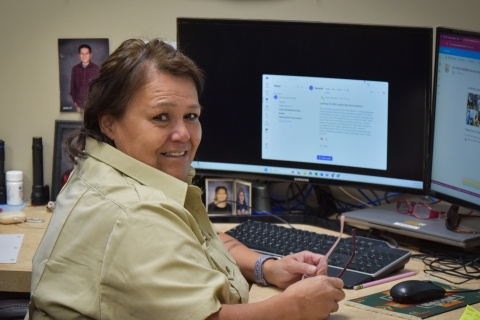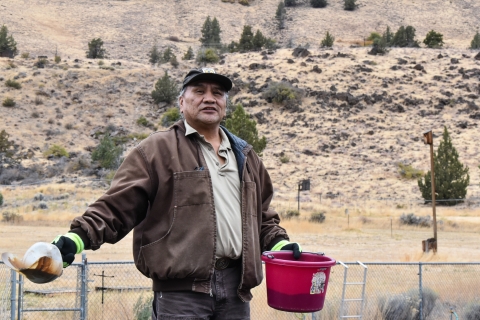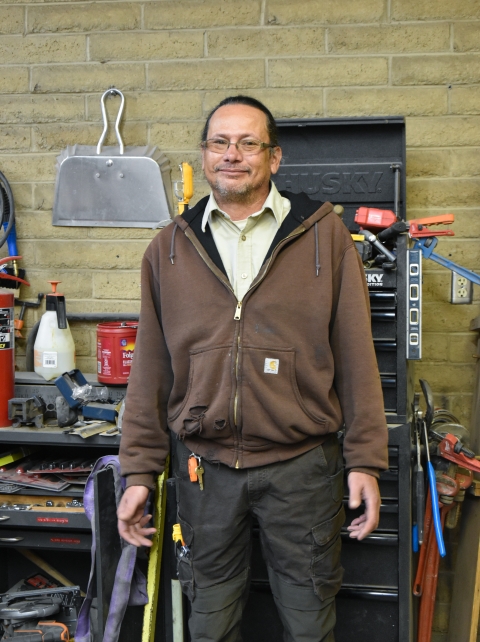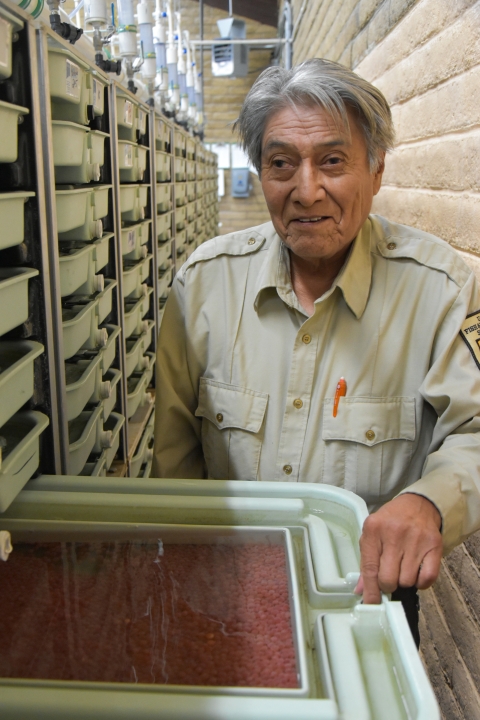Since time immemorial, the Confederated Tribes of the Warm Springs Reservation of Oregon have derived their physical and emotional sustenance from the region's land, water, fish, game, berries, and roots. Warm Springs National Fish Hatchery in Warm Springs, Oregon, releases spring Chinook salmon (hatchery and natural origin) for direct release into the Warm Springs River. The hatchery's program goals are to enhance fishing opportunities in the Columbia and Deschutes river basins and to provide surplus brood stock to the Confederated Tribes of the Warm Springs of Oregon for distribution to their members.
The hatchery is operated by the U. S. Fish and Wildlife Service on lands leased from Confederated Tribes of the Warm Springs Reservation of Oregon and co-managed by both. All operations and production at the hatchery are determined through extensive planning and coordination with the Tribe.
To learn more about a place, it is best to hear from those who live and work there. Employees of the Warm Springs National Fish Hatchery share about their career paths and the meaning of working with the salmon they are so deeply connected to.
Andrea Sapuay, Biological Science Technician
I am a Warm Springs Tribal Member with strong blood lines with Yakama Nation and Colville blood along with Nooksack and Skagit bloodline. As a young child I would help my grandmother preserve our fish by smoke drying, salting, or canning. My grandfather would gather and hunt to feed our family until the next season. Often other families would bring her trunks full of fish to help preserve for their family. Our culture is about sharing and helping one another.
I truly care about my day-to-day activities in working with salmon. Salmon is a very strong part of our family, since the beginning of time. Salmon are considered one of the first of our foods. We have depended on them for thousands of years. When we feast, we are praying for them to return in abundance to continue to take care of our people and families. They are medicine to us.
Sapuay’s career path to the Service
I was working for the Confederated Tribes of Warm Springs-Branch of Natural Resources helping at the hatchery with daily activities. I loved it! There was a position opening up [in the Service], and I applied, and here I am doing my best on giving back to future generations.
At Warm Springs NFH, I do everything from collecting brood (adult salmon), spawning, working in the nursery, cleaning ponds outside, weekly sampling, checking equipment in the mechanical room, greeting visitors, yard work, and maintenance.
Kevin Blueback, Animal Caretaker
I am a member of the Confederated Tribes of Warm Springs – Warm Springs, Yakima, Colville, and Ponca descendent. I grew up in the Columbia River Basin.
[Working with salmon] is very important, very inspiring, following a family in traditional conservation, replenishing the rivers and tributaries for the Columbia River people – my relations, all my relations.
Blueback’scareer path to the Service
I was contacted by Tribal Elder Hamilton Greely in a workforce development program with the Confederated Tribes of Warm Springs. He instructed me that the job will help our people to raise ceremonial first foods of our Tribe.
I have worked for the Service for 27+ years. What led me on this path was raising food for my people in ceremonial traditional meals and providing a way of life for Warm Springs Wasco Piute people.
I would like to see the Service recruit more native Tribal members at National Fish Hatcheries on Tribal lands and continue more Tribal outreach programs and hands-on training for Tribal members in fish hatchery employment on reservations, etc. Fish and wildlife conservation comes naturally to most Tribal members.
The Service has a trust responsibility to the Warm Springs Nation and to Oregon, Washington, and Idaho Tribes to conserve a way of life and for salmon recovery for Native people.
There are hardly any other Tribal members in the Service that I know.
James Sapuay, Maintenance Mechanic
I am descended from the Klickitat Band of the Yakama Nation, Lower Cowlitz, and Mission Bands of California
[Working with salmon] makes me try to always make improvements and puts a deep passion in me.
My background is in maintenance and repair and construction work. I found my career with the Service through my wife, Andrea. Working with other Native Americans has been fun because we all have similar backgrounds and beliefs – working at Warm Springs National Fish Hatchery is most rewarding job I have ever had.
Joe Badoni, Animal Caretaker
I’m a Navajo from Arizona. I came up to Oregon (The Dalles) for high school. I was an animal caretaker when I was growing up, my family raised sheep and other animals, but mainly sheep.
Here, we raise salmon and release them to return in 3 to 5 years. I was working for the Confederated Tribes of the Warm Springs Reservation of Oregon before working for the Service; I started as temporary help that led to a full time Animal Caretaker.
The mission of the U.S. Fish and Wildlife Service is working with others to conserve, protect, and enhance fish, wildlife, plants, and their habitats for the continuing benefit of the American people. Learn more about jobs, internships, and careers with the U.S. Fish and Wildlife Service







